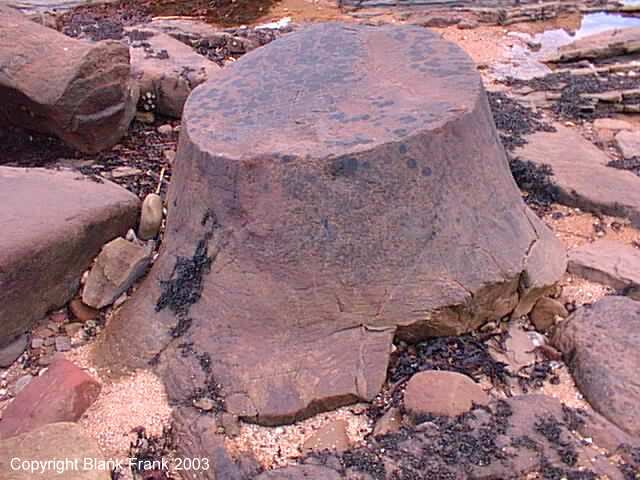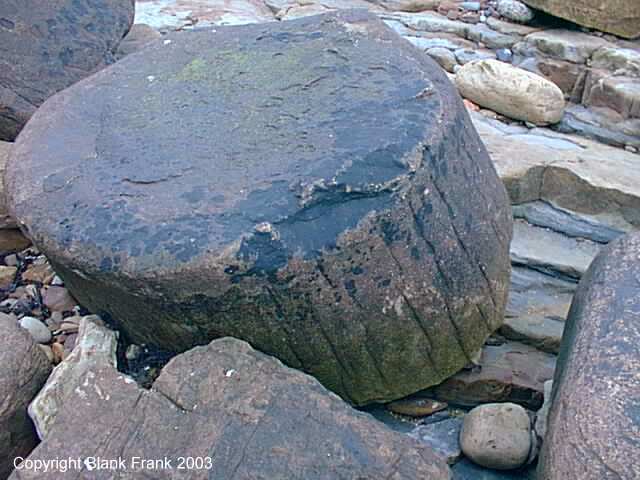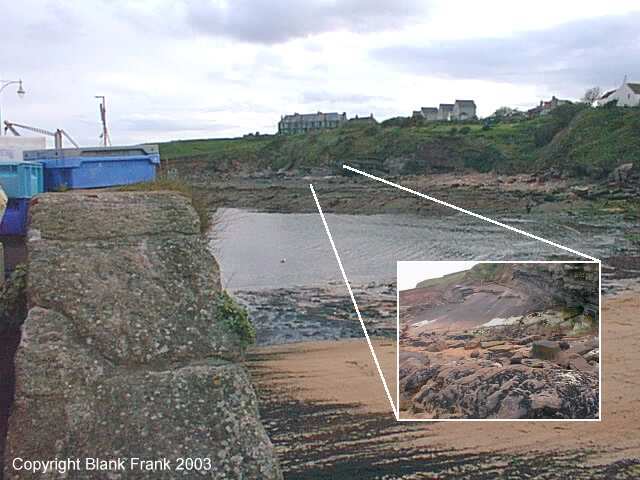
The Bonnet Stane, Carlin Maggie and Buddo Rock featured elsewhere on these pages are rocks with the common feature that they were all shaped by erosion of one sort or another. The rocks on this page are different because they were formed by fossilization and then uncovered by erosion. We are talking here about great big chunks of fossil trees, located on the seashore close to Crail harbour, in SE Fife, Scotland. I suspect they are well-enough known locally, but their existence may come as a bit of a surprise to those who live further away, so I thought I'd bring them to your attention so you can check them out if you happen to be in the area.
As I said on another page, I am not a geologist, but here's my attempt at an explanation of what's going on on this site. Crail harbour is really rather a poor excuse for a harbour - it is more-or-less completely empty at low tide, and the bay in which it sits is full of sharp ridges of rock which must make navigation extremely hazardous for all except the smallest boats even when the tide is in. The ridges are what is left of layers of soft, sedimentary rock which rise with perhaps a 25 degree slope towards the West. They have been washed away, leaving the rough bottom and an exposed, rotting cliff at the Western edge of the bay. The continuing erosion of the cliff has removed most of the soft stuff, leaving behind some harder material which was formerly embedded in it - in this case, amongst other things, the bits of fossil tree. No doubt a bit of excavation and careful searching would reveal other interesting things - I saw some promising-looking bits of exposed rock in the vicinity of the fossils.
The two photos below show the two obvious bits of fossil tree. The first photo is actually the second bit you come across as you move round the bay from the harbour, but it is the more obvious. The top is slightly over a metre across, and you can see from the shape that this was at the taper where the roots change to the trunk. It must have been a big tree. The exact grid reference is NO 61061 07227. The second photo is a slightly smaller chunk, but from a different tree - viewed from different angles, it shows a similar taper, and is probably also from just above root level. In this case you can see markings on the side which - in my opinion - are the imprints of bark. It is a few metres North of the other chunk, closer to the cliff and more crowded by other lumps of stone.


This next photo is to give you an idea of where to look if you don't have your GPS unit with you. The shot was taken from the NW corner of Crail harbour wall. From here, you just step down onto the little sandy beach, walk round to the far side and along the shore to the site (there be slippery rocks, so wear stout, waterproof footwear and be prepared to scramble a bit). Don't go at high tide (as I did the first time) or you'll get your feet wet (and possibly get cut off and / or drown) and the fossils will probably be submerged. If you reach a very obvious sloping sheet of rock protruding from the cliff (shown inset, with fossil 2 in front), you've gone a few metres too far. The whole walking bit should only take a few minutes. I won't insult you with details of how to get to Crail.
